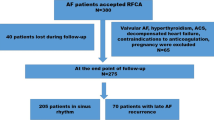Abstract
Background
Whether there are many risk factors for recurrence of atrial fibrillation (AF) after ablation is unclear. The aim of this study was to investigate the relationship between insulin resistance (IR) and AF recurrence in patients without diabetes who underwent catheter ablation.
Methods
This retrospective study included patients who underwent AF ablation between 2018 and 2019 at the First Affiliated Hospital of Zhengzhou University. Homeostasis model assessment of insulin resistance (HOMA-IR) was calculated, and a value of ≥2.69 was defined as IR. The patients were divided into two groups (group 1 HOMA-IR < 2.69, n = 163; group 2 HOMA-IR ≥ 2.69, n = 69). AF recurrence was defined as the occurrence of atrial arrhythmias of more than 30 s after the first 3 months. Univariate and multivariable Cox regression models were used to analyse the risk of AF recurrence.
Results
Overall, 232 patients were enrolled (mean age, 59.9 ± 10.2 years old; female, 37.5%; paroxysmal AF, 71.6%). We found that dyslipidaemia, antiarrhythmic drug use, fasting blood glucose and fasting insulin were significantly higher in the IR group (P < 0.05). During the follow-up 1 year after ablation, 62 (26.7%) patients experienced AF recurrence. After adjusting for traditional risk factors, multivariable analysis showed that the HOMA-IR value (HR 1.259, 95% CI 1.086–1.460, P = 0.002) and left atrial diameter (LAD; HR 1.043, 95% CI 1.005–1.083, P = 0.026) were independently associated with AF recurrence.
Conclusions
The present results provide evidence that IR patients are more likely to experience AF recurrence. Improving IR status may be a potential target for reducing the postoperative recurrence rate.




Similar content being viewed by others
Data Availability
The data supporting the findings of this study are available on request.
Change history
21 March 2022
A Correction to this paper has been published: https://doi.org/10.1007/s10557-022-07333-z
References
Packer DL, Mark DB, Robb RA, Monahan KH, Bahnson TD, Poole JE, CABANA Investigators, et al. Effect of catheter ablation vs antiarrhythmic drug therapy on mortality, stroke, bleeding, and cardiac arrest among patients with atrial fibrillation: the CABANA randomized clinical trial. JAMA. 2019;321(13):1261–74.
Latchamsetty R, Morady F. Atrial fibrillation ablation. Annu Rev Med. 2018;69:53–63.
Brooks AG, Stiles MK, Laborderie J, Lau DH, Kuklik P, Shipp NJ, et al. Outcomes of long-standing persistent atrial fibrillation ablation: a systematic review. Heart Rhythm. 2010;7(6):835–46.
Buist TJ, Zipes DP, Elvan A. Atrial fibrillation ablation strategies and technologies: past, present, and future. Clin Res Cardiol. 2021;110(6):775–88.
Gluvic Z, Zaric B, Resanovic I, Obradovic M, Mitrovic A, Radak D, et al. Link between metabolic syndrome and insulin resistance. Curr Vasc Pharmacol. 2017;15(1):30–9.
Ahn HJ, Han KD, Choi EK, Jung JH, Kwon S, Lee SR, et al. Cumulative burden of metabolic syndrome and its components on the risk of atrial fibrillation: a nationwide population-based study. Cardiovasc Diabetol. 2021;20(1):20.
Creta A, Providência R, Adragão P, de Asmundis C, Chun J, Chierchia G, et al. Impact of Type-2 diabetes mellitus on the outcomes of catheter ablation of atrial fibrillation (European observational multicentre study). Am J Cardiol. 2020;125(6):901–6.
Nattel S. Molecular and cellular mechanisms of atrial fibrosis in atrial fibrillation. JACC Clin Electrophysiol. 2017;3(5):425–35.
Polovina M, Krljanac G, Ašanin M, Seferović PM. Crouching tiger, hidden dragon: insulin resistance and the risk of atrial fibrillation. Eur J Prev Cardiol. 2020;27(18):1931–3.
Andrade J, Khairy P, Dobrev D, Nattel S. The clinical profile and pathophysiology of atrial fibrillation: relationships among clinical features, epidemiology, and mechanisms. Circ Res. 2014;114(9):1453–68.
Hsu JC, Maddox TM, Kennedy KF, Katz DF, Marzec LN, Lubitz SA, et al. Oral anticoagulant therapy prescription in patients with atrial fibrillation across the Spectrum of stroke risk: insights from the NCDR PINNACLE registry. JAMA Cardiol. 2016;1(1):55–62.
Matthews DR, Hosker JP, Rudenski AS, Naylor BA, Treacher DF, Turner RC. Homeostasis model assessment: insulin resistance and beta-cell function from fasting plasma glucose and insulin concentrations in man. Diabetologia. 1985;28(7):412–9.
Ford ES, Giles WH. A comparison of the prevalence of the metabolic syndrome using two proposed definitions. Diabetes Care. 2003;26(3):575–81.
Yang WB, Wang HL, Mao JT, Chen Z, Xu JW, Wang LH, et al. The correlation between CT features and insulin resistance levels in patients with T2DM complicated with primary pulmonary tuberculosis. J Cell Physiol. 2020;235(12):9370–7.
Zhou M, Zhu L, Cui X, Feng L, Zhao X, He S, et al. The triglyceride to high-density lipoprotein cholesterol (TG/HDL-C) ratio as a predictor of insulin resistance but not of β cell function in a Chinese population with different glucose tolerance status. Lipids Health Dis. 2016;15:104.
Tang Q, Li X, Song P, Xu L. Optimal cut-off values for the homeostasis model assessment of insulin resistance (HOMA-IR) and pre-diabetes screening: developments in research and prospects for the future. Drug Discov Ther. 2015;9(6):380–5.
Dong JZ, Sang CH, Yu RH, Long DY, Tang RB, Jiang CX, Ning M, Liu N, Liu XP, Du X, Tse HF, Ma CS. Prospective randomized comparison between a fixed '2C3L' approach vs. stepwise approach for catheter ablation of persistent atrial fibrillation. Europace. 2015;17(12):1798–806.
Hammoudeh AJ, Khader Y, Kadri N, Al-Mousa E, Badaineh Y, Habahbeh L, et al. Adherence to the 2019 AHA/ACC/HRS focused update of the 2014 AHA/ACC/HRS guideline on the use of Oral anticoagulant agents in middle eastern patients with atrial fibrillation: the Jordan atrial fibrillation (JoFib) study. Int J Vasc Med. 2021;2021:5515089.
Fujino T, Yuzawa H, Kinoshita T, Koike H, Shinohara M, Akitsu K, et al. Clinical factors associated with a successful catheter ablation outcome in elderly patients with atrial fibrillation. Int Heart J. 2020;61(1):21–8.
Bajraktari G, Bytyçi I, Henein MY. Left atrial structure and function predictors of recurrent fibrillation after catheter ablation: a systematic review and meta-analysis. Clin Physiol Funct Imaging. 2020;40(1):1–13.
Hijioka N, Kamioka M, Matsumoto Y, Nodera M, Yamada S, Kaneshiro T, et al. Clinical impact of insulin resistance on pulmonary vein isolation outcome in patients with paroxysmal atrial fibrillation. J Cardiovasc Electrophysiol. 2019;30(4):479–86.
Ndisang JF, Vannacci A, Rastogi S. Insulin resistance, type 1 and type 2 diabetes, and related complications 2017. J Diabetes Res. 2017;2017:1478294.
Park YJ, Han SM, Huh JY, Kim JB. Emerging roles of epigenetic regulation in obesity and metabolic disease. J Biol Chem. 2021;297(5):101296.
Sivasambu B, Balouch MA, Zghaib T, Bajwa RJ, Chrispin J, Berger RD, et al. Increased rates of atrial fibrillation recurrence following pulmonary vein isolation in overweight and obese patients. J Cardiovasc Electrophysiol. 2018;29(2):239–45.
Middeldorp ME, Ariyaratnam J, Lau D, Sanders P. Lifestyle modifications for treatment of atrial fibrillation. Heart. 2020;106(5):325–32.
Maria Z, Campolo AR, Scherlag BJ, Ritchey JW, Lacombe VA. Dysregulation of insulin-sensitive glucose transporters during insulin resistance-induced atrial fibrillation. Biochim Biophys Acta Mol basis Dis. 2018;1864(4 Pt A):987–96.
Shigematsu Y, Hamada M, Nagai T, Nishimura K, Inoue K, Suzuki J, et al. Risk for atrial fibrillation in patients with hypertrophic cardiomyopathy: association with insulin resistance. J Cardiol. 2011;58(1):18–25.
Lee Y, Cha SJ, Park JH, Shin JH, Lim YH, Park HC, et al. Association between insulin resistance and risk of atrial fibrillation in non-diabetics. Eur J Prev Cardiol. 2020;27(18):1934–41.
Chao TF, Suenari K, Chang SL, Lin YJ, Lo LW, Hu YF, et al. Atrial substrate properties and outcome of catheter ablation in patients with paroxysmal atrial fibrillation associated with diabetes mellitus or impaired fasting glucose. Am J Cardiol. 2010;106(11):1615–20.
Funding
This study was partly supported by the National Key Research and Development Program (2016YFC1301000), awarded to Dr. Jianzeng Dong, MD, PhD.
Author information
Authors and Affiliations
Contributions
ZW: Designed the study and wrote the manuscript. YJW, ZYL, and QL: Contributed to writing of the manuscript. YWK: Participated in data analysis. YWC and YHS: Supervised the data acquisition, data analysis and interpretation. JZD: Verified the data extraction and reviewed the manuscript. All authors read and approved the final manuscript.
Corresponding authors
Ethics declarations
Conflict of Interest
The authors declare that they have no conflicts of interest.
Informed Consent
Informed consent was obtained from all individual participants included in the study.
Additional information
Publisher’s Note
Springer Nature remains neutral with regard to jurisdictional claims in published maps and institutional affiliations.
Supplementary Information
ESM 1
(DOCX 18 kb)
Rights and permissions
About this article
Cite this article
Wang, Z., Wang, YJ., Liu, ZY. et al. Effect of Insulin Resistance on Recurrence after Radiofrequency Catheter Ablation in Patients with Atrial Fibrillation. Cardiovasc Drugs Ther 37, 705–713 (2023). https://doi.org/10.1007/s10557-022-07317-z
Accepted:
Published:
Issue Date:
DOI: https://doi.org/10.1007/s10557-022-07317-z



